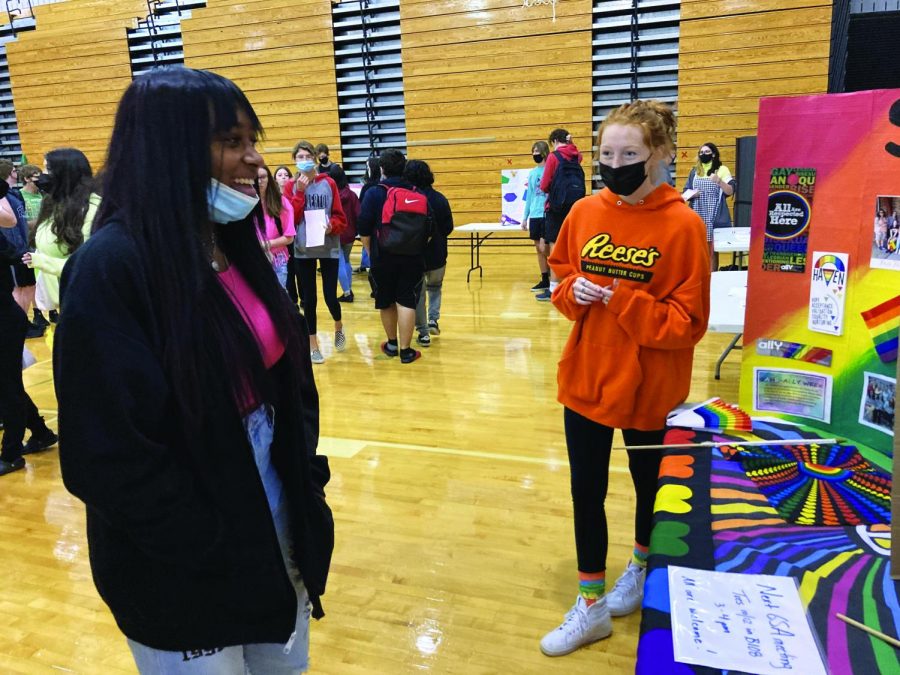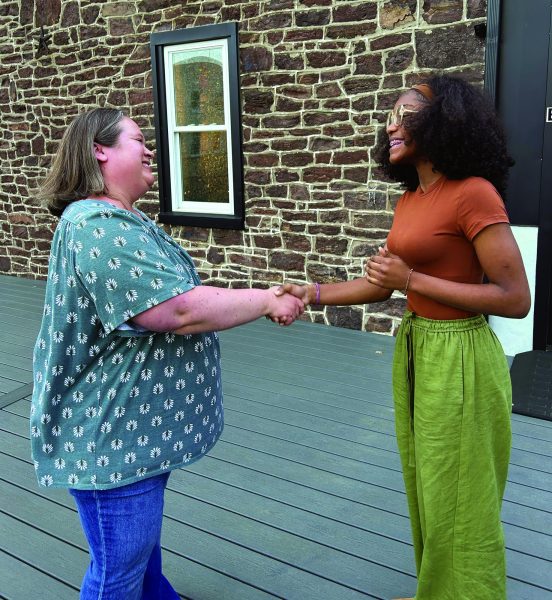Students, staff on neopronoun usage acceptance
Increasing student self-expression, as well as the acceptance of diversity, is resulting in an increase in the use of neopronouns being used among students.
Creating connections…Managing the Gay Straight Alliance Club’s booth at the club fair on October 5, senior Alanna Hilton (right) speaks to freshman Mira Baker. The GSA’s goal was to recruit freshmen to join their LGBTQ+ supportive environment.
To support diversity and acceptance within the school, Souderton students and staff are providing insight on neopronouns, which some Souderton students use to identify themselves, increasingly so in recent years.
Neopronouns are defined by UNC Greensboro as a “category of new (neo) pronouns that are increasingly used in place of ‘she,’ ‘he,’ or ‘they’ when referring to a person.”
These pronouns, according to Gay-Straight Alliance co-advisor Allyson Fitzpatrick, have become “more mainstream and accepted” over the past 5-6 years.
Junior Benjamin Smith* said that the concept of these pronouns as a form of self-expression and perception is easy to grasp, even for their sibling who is in middle school.
So, why aren’t these types of pronouns, such as ‘xe/xym’, heard in the halls of Souderton thus far?
According to Smith, the answer lies in some peoples’ stubbornness and unwillingness to change and accept.
“People just refuse to get adjusted to changing,” Smith said. “It shouldn’t be too big of a deal and it’s kind of frustrating that people make it one.”
However, optimism lies in the hearts of some Souderton students and staff.
“I think Souderton is a lot more supportive than other schools,” said Fitzpatrick. “Students have always been able to wear whatever color cap and gown they’re comfortable with. I mean, that’s just always been accepted.”
Fitzpatrick feels that this type of support may be a foreshadowing of the future greater acceptance of neopronouns.
Art teacher Sabrina Pistoria agrees.
“Even since my experience in school it’s much more common, more embraced, in my opinion,” Pistoria said.
According to sophomore Audrey Bucher, a good way to encourage this acceptance is to simply ask people what pronouns they use. “They could ask people who use them, and how they can make them feel more comfortable,” Bucher said.
Some students and staff feel that this is the best way to go when it comes to respecting the way others identify.
“It’s just a part of identity that people need to know to refer to you, as it’s no different than asking someone’s name,” Smith said.
Fitzpatrick encourages teachers, as well, to encourage the acceptance of neopronouns.
“If teachers are comfortable with saying, ‘Let’s go around the room, let’s introduce ourselves and let’s share our pronouns,’ we can really encourage the support of that diversity,” Fitzpatrick said.
She also encourages the use of student’s names in the case that their pronouns are forgotten, and to ask the student for clarification.
Pistoria feels that this type of acceptance can be encouraged by talking to others who might identify differently.
According to Fitzpatrick, the most important takeaway from the recent rise of neopronouns is that the younger generation is making the world more aware and accepting of its diversity.
“The more we learn, the more we ask, the more young people educate us, the better off we are” said Fitzpatrick, “and we need that, we absolutely need that. It’s too easy to conform, but to stand out and be yourself, that’s what makes it this beautiful world.”
Smith encourages students to use these methods to try to make an impact in the acceptance of neopronouns.
“Try and make a safer environment for people, because your identity isn’t really something you can control,” Smith said. “I just want it to be a safe place for everybody who identifies a little bit differently than in older times.”
According to Merriam-Webster, the gender-neutral pronoun “thon” appeared in the dictionary from 1934-1961.
This word was coined in 1858, showing that though neopronouns mean literally “new pronouns”, gender-neutral pronouns are far from new. According to Merriam-Webster’s Dictionary of English Usage, 1994, “We must remember that the English pronoun system is not fixed.”
*In order to protect students’ identities, some names in this article have been changed.







Mrs. Moyer • Feb 7, 2022 at 9:22 am
Well written Nate